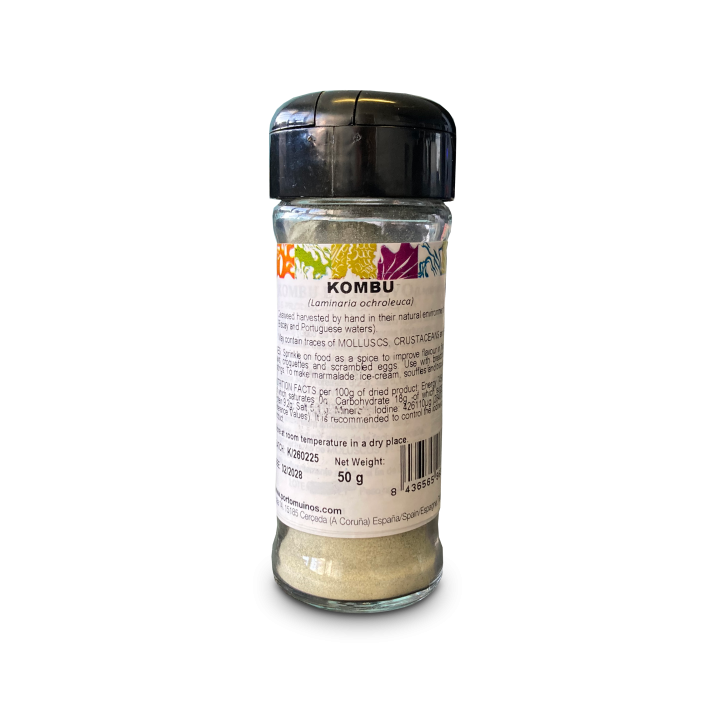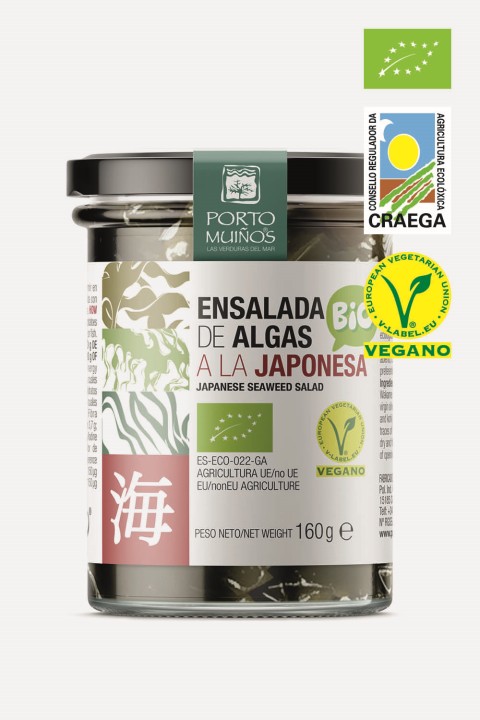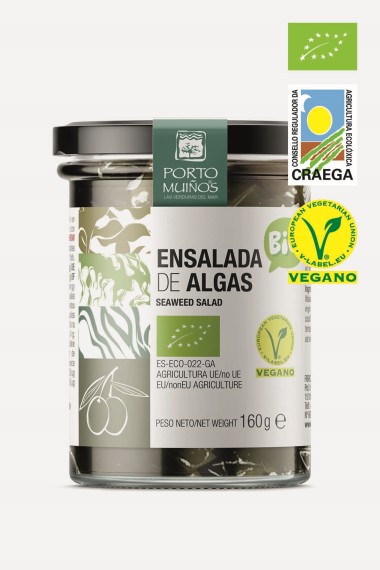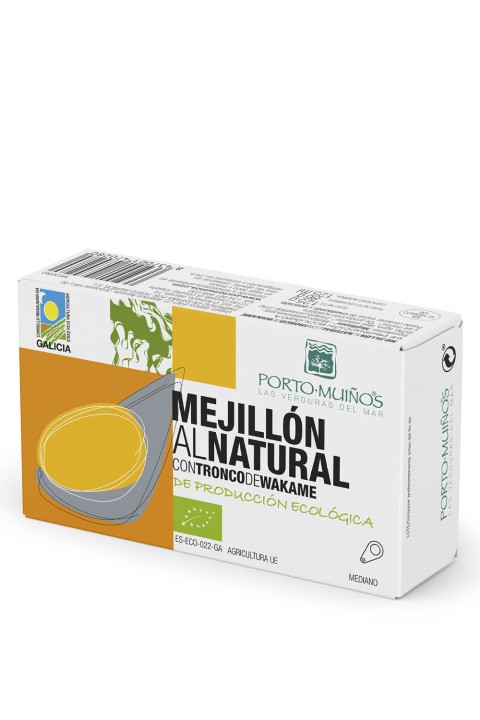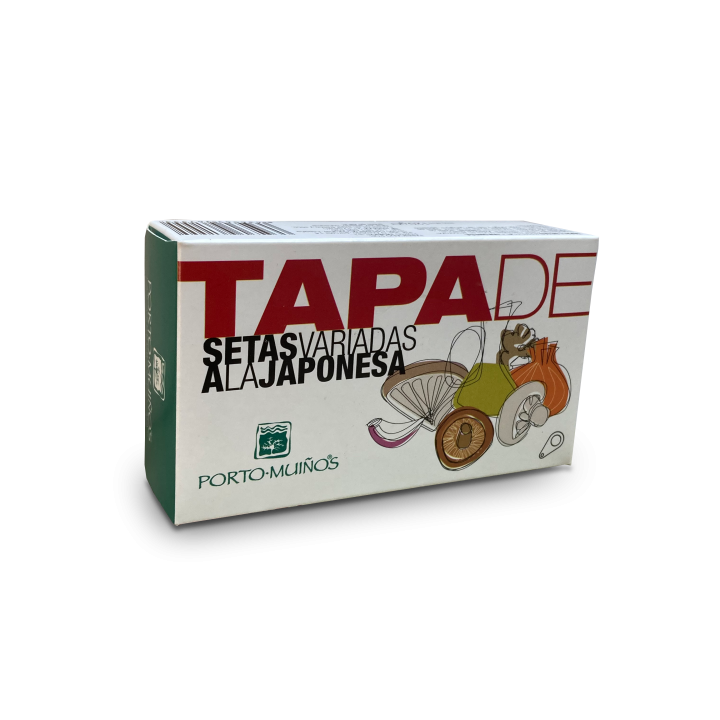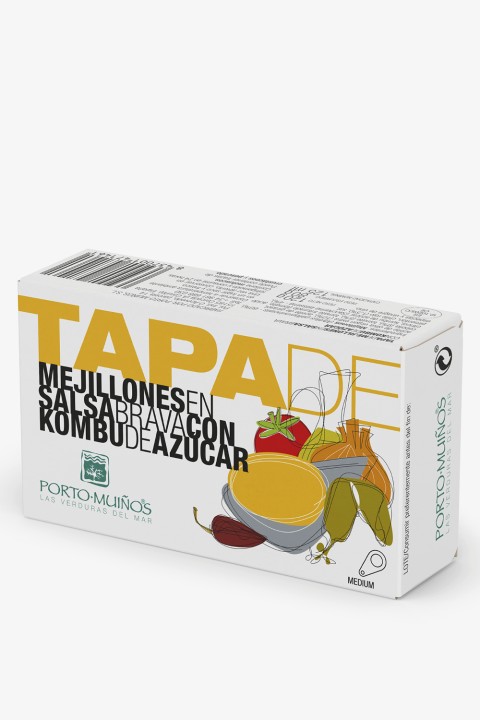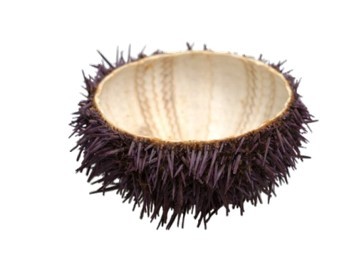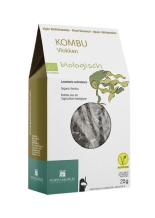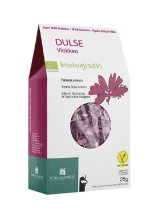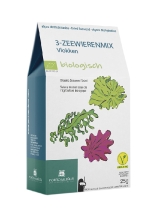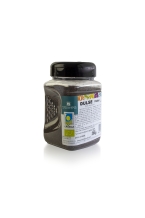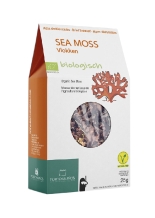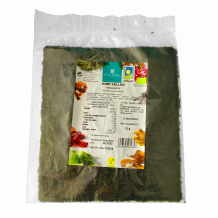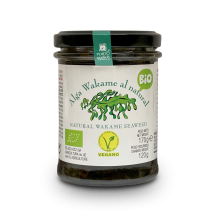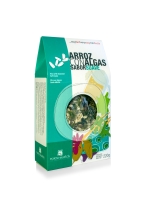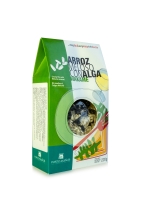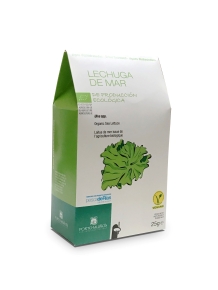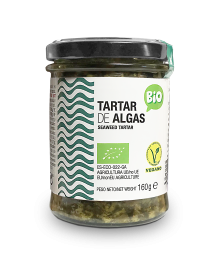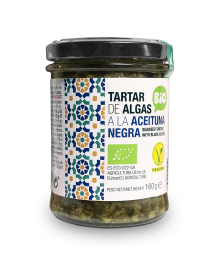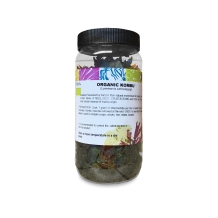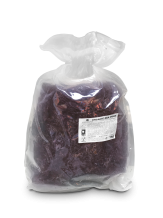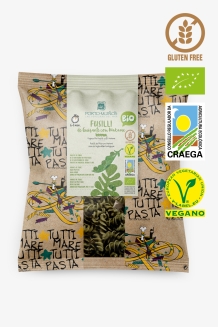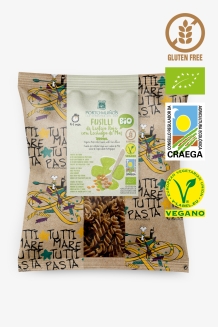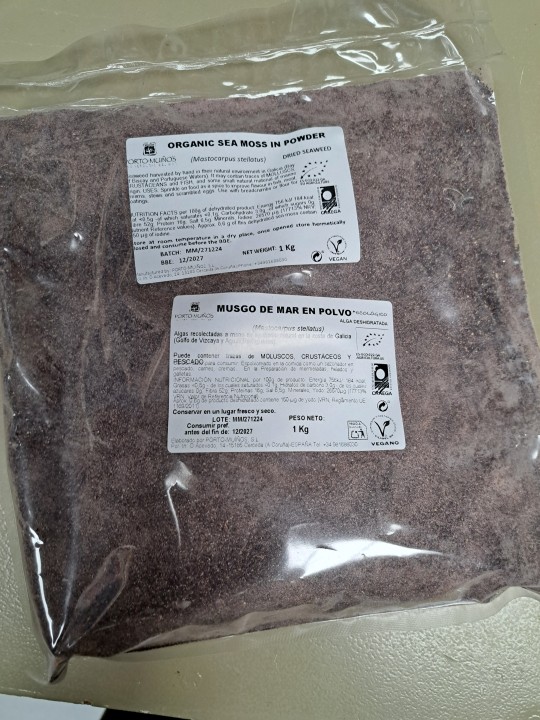Porto-Muiños
39 Items
Brand: Porto-Muiños
Kombu seaweed powder in 50g shaker. A good alternative to salt. Kombu has a low sodium content without compromising on flavour. Tasty and healthy seasoning.
Brand: Porto-Muiños
Salad with three types of seaweed (wakame, kombu and sea spaghetti) with oil and soy sauce. Seaweed from Galicia seasoned with a Japanese touch. Ingredients: Seaweed* 65% (Sea spaghetti, wakame, kombu), extra virgin olive oil*, sunflower oil*, SOY sauce* (water, SOY*, WHEAT*, sea salt and kohi), SESAME* and sea salt. *from organic production. The seaweed...
Brand: Porto-Muiños
Salad with three types of seaweed (wakame, kombu and sea spaghetti) with oil and soy sauce. Seaweed from Galicia seasoned with a Japanese touch. Ingredients: Seaweed* 65% (Sea spaghetti, wakame, kombu), extra virgin olive oil*, sunflower oil*, SOY sauce* (water, SOY*, WHEAT*, sea salt and kohi), SESAME* and sea salt. *from organic production. The seaw...
Brand: Porto-Muiños
Monkfish liver has a soft texture and an oily sea flavour. The oil is coral-coloured. It is considered a delicacy in France and Japan. Rich in omega 3 Ingredients: Monkfish liver (Lophius piscatorius), water and sea salt. May contain traces of molluscs and crustaceans Use : ready to use. As a garnish or in the preparation of , with seafood and fish...
Brand: Porto-Muiños
Ingredients: Mussels* (Mytilus galloprovincialis - 55%), extra virgin olive oil*, wakame* (Undaria pinnatifida -13%), cider vinegar*, garlic* (6%), balsamic vinegar* and sea salt. May contain traces of shellfish and fish Use : ready to use. As an aperitif, hot or cold. With fish and seafood, potato, rice and pasta dishes. Keep closed and refrigerated...
Brand: Porto-Muiños
Mussels grown on rafts in Galician (Spain) estuaries with the grain of wakame. Organically certified. The rafts are wooden structures with hanging ropes used for mussel farming. In Galicia, the origins of this sustainable method date back to the mid-20th century. Rafts represent a feature of the coastal landscape, as important as "horreos, the traditional g...
Brand: Porto-Muiños
Ingredients: cultivated mushrooms (Pleurotos ostraetus, Agricus bisporus, Lentinula edodes) extra virgin olive oil, onion, sunflower oil, SOY sauce (water, SOY, WHEAT, and salt), garlic, ginger, SESAME and spices. Contains SULFITES Store at room temperature. Origin: Spain in a dark and dry place. Once opened, keep in the refrigerator for a maximum of 2 ...
Brand: Porto-Muiños
An innovative concept for ready-to-eat canned food. Tapa of mussels in spicy brava sauce with royal kombu seaweed. A new line and an innovative concept in canned food (ready-to-eat as a tapa). No preparation required. As an aperitif, at room temperature or warm Pairing: manzanilla wine, fine or young sparkling wine, fresh and light beers. Ingredients: ...
Brand: Porto-Muiños
Tapa of mussels in spicy brava sauce with sweet kombu seaweed. A new line and an innovative concept in canned food (ready to eat as a tapa). Geen voorbereiding nodig. Als aperitief, op kamertemperatuur of warm Pairing : Red vermouths, generous Amontillado or Oloroso wijnen, toasted beers, young and fruity wines from carbonic maceration Ingredients: M...
Brand: Porto-Muiños
Authentic sea urchin roe from the Galician coast (Spain) with seaweed, canned. The sea urchin is a shellfish with a smooth consistency, orange colour, intense flavour and rich in proteins. Ingredients : Wakame (Undaria pinnatifida - 65%), sea urchin roe (Paracentrotus lividus - 20%), water and sea salt May contain traces of molluscs, crustaceans and fis...
Brand: Porto-Muiños
Tapa of chicory with walnuts and wakame seaweed. A new line and an innovative concept in canned food (ready-to-eat as a tapa). No preparation required. As an aperitif, at room temperature or warm Pairing: white wine matured in barrels, white vermouth, toasted and intense beers Ingredients: Chicory (65%), extra virgin olive oil, sunflower oil, WALNUTS ...
Brand: Porto-Muiños
Sea urchins (sea apples, sea urchins; class Echinoidea) are spiny, invertebrate animals that belong to the phylum echinoderms (Echinodermata).There are app. 900 different kinds. Sea urchins are usually more or less spherical, heart-shaped or disc-shaped and have an inferior mouth. They have a hard shell that is usually covered with spines. The shell consis...
Brand: Porto-Muiños
Kombu is traditionally used to flavor water for soup, stock, vegetables, stews, fish, seafood, sauces, etc.The recommended dosage for 1 liter is 1 gram of dried kombu. Use: Cook the kombu for 5 minutes. Remove the kombu from the liquid when it is to taste and use only the liquid. You can reuse Kombu by letting it dry and using it every time until it is...
Brand: Porto-Muiños
Ingredients: dried seaweed * (Palmaria palmate / dulse) * From organic origin Now in compostable packaging! Origin: Seaweed harvested by hand in its natural environment on the coast of West Ireland.and Brittanny Use: Soak in water for 5 minutes. Boil for 15 minutes (Dulse gains weight 4 times) Sprinkle dried Dulse flakes over your dish, for ex...
Brand: Porto-Muiños
The fine crustacean-like texture of sea lettuce and nori is combined with the slightly crispy and fleshy texture of wakame. Use The 3-Seaweed mix soaked or roasted in salads, or cook and use in soups, egg dishes, croquettes, sauces, stews, pies. Also delicious as a garnish over fish and seafood or added to rice and pasta dishes. Cover with water and s...
Brand: Porto-Muiños
Sprinkle Dulse powder as a seasoning over all your dishes, for example over salads, with meat and fish dishes. It is also used by soups, scrambled eggs, croquettes, pies or pasties, rice, pasta, etc ... Ingredients: dried seaweed * (Palmaria palmate / dulse) * Of organic origin ADDITIONAL INFORMATION / ALLERGENS The seaweed can contain smal...
Brand: Porto-Muiños
Ingredients: 100% seaweed (Undaria pinnatifida) Use: Wakame flakes can be used to flavor many dishes: salad, fish, egg, soups and sauces (add at the end of the preparation). Soaking for 10 minutes in cold water provides a tasty base for a wakame salad. Texture: slightly fleshy and fibrous Soaked (about 10 minutes) : add to salad, soups or use as ...
Brand: Porto-Muiños
Ingredients : dried Sea moss* (Mastocarpus stellatus) *Of biological origin Origin : harvested by hand in its natural environment on the coast of Galicia (Bay of Biscay and Portuguese Waters). Sea moss has a spongy structure, with branched leaves and a narrow curled or twisted shape. Sea moss is a small red seaweed that turns green when heated. It has...
Brand: Porto-Muiños
Organic Nori sushi sheets, dried and roasted Ingredients: Nori seaweed (Porphyra yezoensis)* *organic Use: Is used for making sushi, but it can be used cut with any dish. After preparation, for example, over fish, vegetables or salads or delicious from the hand. Delicious for everyone. Store at room temperature in a dark and dry place. Once opened, ...
Brand: Porto-Muiños
Plain seaweed from the Galician Sea with all the flavor and richness of the cold waters of the Atlantic Ocean. Use Ready for use. Requires no prior preparation to be consumed. It is used as an ingredient in fish stews, salads, soups, noodles, stews and scrambled eggs. Ingredients: Wakame* seaweed (Undaria pinnatifida), water and sea salt....
Brand: Porto-Muiños
It can be used with salads, pasta, rice. Also for making scrambled eggs, canapés and snacks. General: the recommended dose is about 5 grams of seaweed per day. Ingredients: Sea spaghetti seaweed* (Himanthalia elongata – ), sunflower oil*, cider vinegar*, garlic shoots*, water and sea salt. *Ingredients from organic production. ...
Brand: Porto-Muiños
Vegan reinterpretation of the traditional Argentine sauce with the unique flavor and properties of Galician seaweeds. Organic production ( Himanthalia elongata, undaria pinnatifida and Ulva spp.). Use It is ideal to accompany grilled or charcoal-grilled meat, fish and seafood. Use it to dress potatoes and steamed, boiled, roasted or grilled vege...
Brand: Porto-Muiños
Prepare according to the directions and eat as a single or main course. Delicious with mussels, cockles and cockles. Use In a saucepan on the stove, put 15 g (2 tablespoons) of olive oil, add the contents of the bag and simmer for 15 seconds. Add 800g water (preferably hot) and cook over medium heat for 15-18 minutes. Stir to prevent sticking ...
Brand: Porto-Muiños
Codium Seaweed, (Codium spp.) oranic production. Seaweed recollected by hand in their natural environment in the galician coast (Bay of Biscay and Portuguese waters). Dark green seaweed. Spongy texture, elastic and velvety to the touch when hydrated. Very intense marine flavor. Use Ready to use. Does not require prior preparation. Add directly a...
Brand: Porto-Muiños
Prepare according to the directions and eat as a single or main course. Delicious with mussels, cockles and cockles. These can be added 3 minutes before the end. You can also add shellfish (prawns, crayfish, prawns, etc.) 2 minutes before the end, previously fried, before you finish cooking. If you add wild asparagus, Parmesan cheese, rabbit, you get new di...
Brand: Porto-Muiños
Nori is a red algae and a good source of proteins, vitamins, minerals and contains little sodium. In Ireland it is eaten raw as a snack, but you can also bake or deep fry it. Ingredients: dried seaweed* (Porphyra spp.) *Originated origin Now in compostable packaging! Origin: Seaweed harvested by hand in its natural environment in the Northwest of A...
Brand: Porto-Muiños
Buy 1 for your self and get 1 for free to give away! For food use as a gelling binder, thickener and stabilizer. Gelling and stabilizing in jams, jellies, juices, compotes, pies, custard, yogurt, curd, etc. Thickener, in low concentration, in custard, ice creams, mayonnaise and other sauces. Ingredients: Agar-Agar (E-406) powder. AGAR-AGAR the sea gel...
Brand: Porto-Muiños
For food use as a gelling binder, thickener and stabilizer. Gelling and stabilizing in jams, jellies, juices, compotes, pies, custard, yogurt, curd, etc. Thickener, in low concentration, in custard, ice creams, mayonnaise and other sauces. Ingredients: dried seaweed* (Porphyra spp.) *Originated origin Origin: Usage: Prior p...
Brand: Porto-Muiños
Ingredients: 100% seaweed* (Himanthalia elongata) *of organic origin Origin: hand-harvested in the natural environment of the seaweed on the coast of Galicia (Bay of Biscay and Portuguese waters) Sea spaghetti or sea beans (Himanthalia Elongata), also called belt seaweed, consists of two to three meter long green-brown strings and grows at a maximum ...
Brand: Porto-Muiños
Ingredients: 100% seaweed* (Ulva lactuca) *of organic origin Origin : hand-harvested in the natural environment of the seaweed on the coast of Galicia (Bay of Biscay and Portuguese waters) Sea lettuce. Although it may seem like it, sea lettuce is not related to the regular lettuce, but owes its name to the large green leaves. As the name suggests, it ...
Brand: Porto-Muiños
Ingredients: seaweed*: seaspaghetti, wakame, sea lettuce (53%), extra virgin olive oil*, pickles*, sunflower seed oil*, onion*, capers*, water, sea salt and spices* * = of organic origin May contain traces of molluscs, crustaceans and fish. Store at room temperature in a cool and dry place, keep refriggerated after opening and consume ...
Brand: Porto-Muiños
Ingredients: seaweed*: seaspaghetti, wakame, sea lettuce (53%), extra virgin olive oil*, pickles*, sunflower seed oil*, onion*, capers*, black olives, water, sea salt and spices* * = of organic origin May contain traces of molluscs, crustaceans and fish. Store at room temperature in a cool and dry place, keep refriggerated after openin...
Brand: Porto-Muiños
Ingredients: seaweed*: seaspaghetti, wakame, sea lettuce (53%), extra virgin olive oil*, pickles*, sunflower seed oil*, onion*, capers*, water, sea salt, curry* (contains mustard) and spices* * = of organic origin May contain traces of molluscs, crustaceans and fish. Store at room temperature in a cool and dry place, keep refriggerated...
Brand: Porto-Muiños
Ingredients: dried seaweed* (kombu/Laminaria Ochroleuca) *of organic origin. Origin: Spain Laminaria, which means 'thin leaf' in Latin, has nearly 300 species, including kombu. These seaweeds are olive brown in color and can be very different in structure and number of leaves. Some have a single broad leaf, others have multiple leaves, some ar...
Brand: Porto-Muiños
I ngredients: dried sea moss* (Mastocarpus stellatus) *Organic origin Origin: Sea moss is harvested by hand in its natural environment in the wild on the coast of Galicia (Bay of Biscay and Portuguese Waters). Sea moss has a spongy structure, with branched leaves and a narrow curled or twisted shape. Sea moss is a small red seaweed that turns green whe...
Brand: Porto-Muiños
What is it? Organic fusilli pasta made from chickpea flour and nori seaweed. Vegan and gluten-free. The seaweed in the pasta does not only add an additional layer of flavor but also helps make the pasta even healthier. Rich in nutrients: Source of fiber, rich in protein, and iodine, source of magnesium, iron and zinc Usage: Boil...
Brand: Porto-Muiños
What is it? Organic fusilli pasta made from pea flour and wakame seaweed. Vegan and gluten-free. The seaweed in the pasta does not only add an additional layer of flavor but also helps make the pasta even healthier. Rich in nutrients: Source of fiber, rich in protein and iodine, source of magnesium, iron and zinc Usage: Boil for...
Brand: Porto-Muiños
What is it? Organic fusilli pasta made from red lentil flour and nori seaweed. Vegan and gluten-free. The seaweed in the pasta does not only add an additional layer of flavor but also helps make the pasta even healthier. Rich in nutrients: Source of fiber, rich in protein, iron and iodine, source of magnesium and zinc Usage: Boi...
Brand: Porto-Muiños
Ingredients : dried sea moss* (Mastocarpus stellatus) *Organic Origin : Sea moss is wild harvested by hand in its natural environment on the coast of Galicia (Bay of Biscay and Portuguese Waters). Sea moss has a spongy structure, with branched leaves and a narrow curled or twisted shape. Sea moss is a small red seaweed that turns green when heated. It h...




